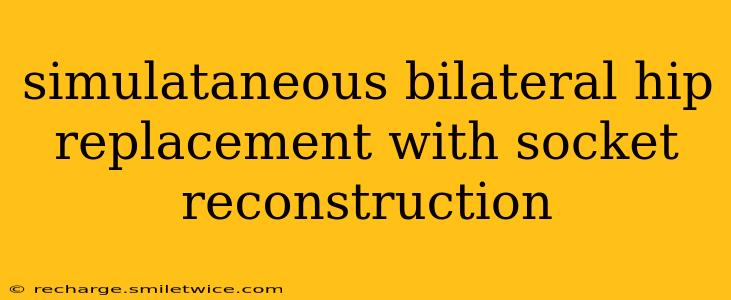Simultaneous bilateral hip replacement (SBHR), also known as double hip replacement, is a major surgical procedure involving the replacement of both hip joints during a single operation. When this procedure also includes socket reconstruction, it signifies a more complex scenario requiring advanced surgical techniques. This comprehensive guide delves into the intricacies of SBHR with socket reconstruction, exploring its indications, benefits, risks, recovery, and more.
What is Simultaneous Bilateral Hip Replacement?
SBHR is a surgical option for individuals suffering from severe bilateral hip osteoarthritis or other debilitating conditions affecting both hip joints. Unlike staged procedures (one hip at a time), SBHR aims to achieve faster recovery and improved functional outcomes by addressing both hips simultaneously. The addition of socket reconstruction further complicates the procedure, implying that the acetabulum (the socket portion of the hip joint) requires significant repair or reconstruction due to damage or deformity. This may involve bone grafting, metal augmentation, or other specialized techniques.
Why is Socket Reconstruction Necessary in Some Cases?
Socket reconstruction becomes necessary in SBHR when the acetabulum is severely damaged, deformed, or unstable. This damage can stem from various causes, including:
- Severe osteoarthritis: Advanced osteoarthritis can significantly erode the cartilage and bone of the acetabulum, necessitating reconstruction to ensure proper implant stability and longevity.
- Fractures: Previous fractures involving the acetabulum may necessitate reconstruction to restore its structural integrity.
- Developmental dysplasia of the hip (DDH): In cases of DDH, the hip socket is abnormally shallow or misaligned, requiring reconstruction to create a stable and appropriately shaped receptacle for the hip implant.
- Previous hip surgery complications: Prior hip surgeries might have resulted in damage to the acetabulum, requiring reconstruction before a successful replacement can be performed.
What are the Benefits of SBHR with Socket Reconstruction?
While it’s a major undertaking, SBHR with socket reconstruction offers several potential advantages:
- Shorter overall recovery time: Compared to staged procedures, SBHR often results in a shorter overall recovery period, although it typically involves a more intensive initial recovery phase.
- Improved functional outcomes: Patients may experience quicker return to functional activities and potentially better long-term mobility.
- Reduced psychological burden: Undergoing the procedure once instead of twice minimizes the stress and anxiety associated with multiple surgeries.
- Cost-effectiveness: In some cases, the overall cost of SBHR might be lower than two separate surgeries.
What are the Risks and Complications of SBHR with Socket Reconstruction?
SBHR with socket reconstruction is a complex and high-risk procedure. Potential complications include:
- Increased risk of infection: The larger surgical site increases the risk of infection compared to a single hip replacement.
- Blood clots (thromboembolism): The longer operating time and larger surgical site increase the risk of deep vein thrombosis (DVT) and pulmonary embolism (PE).
- Nerve damage: Nerve damage is a possible complication, although rare.
- Dislocation: The risk of hip dislocation might be higher, particularly in cases of socket reconstruction.
- Implant failure: Implant loosening or failure is a possibility, especially with complex socket reconstruction.
- Longer hospital stay: Compared to unilateral hip replacement, patients undergoing SBHR with socket reconstruction may require a longer hospital stay.
What is the Recovery Process Like?
Recovery from SBHR with socket reconstruction is a significant commitment requiring diligent adherence to post-operative instructions. Expect:
- Intensive rehabilitation: A comprehensive rehabilitation program is essential to regain strength, mobility, and functional independence.
- Pain management: Effective pain management strategies are crucial during the recovery phase.
- Physical therapy: Regular physical therapy sessions are vital to improving range of motion, strength, and gait.
- Gradual weight-bearing: Weight-bearing restrictions will be prescribed initially, gradually increasing as the healing progresses.
- Potential need for assistive devices: Crutches, walkers, or other assistive devices may be necessary during the early stages of recovery.
How is SBHR with Socket Reconstruction Performed?
The exact surgical technique will depend on the individual's anatomy and the extent of the damage to the hip joints and acetabula. Generally, SBHR with socket reconstruction involves:
- Extensive preoperative planning: This includes imaging studies (X-rays, CT scans), thorough assessment of bone quality and hip joint condition.
- Surgical approach: The surgeon chooses an appropriate approach to access the hip joints.
- Socket reconstruction: The damaged acetabulum is carefully prepared, and the necessary reconstruction techniques are applied. This might involve bone grafting, the use of metal augments, or other specialized implants.
- Implant insertion: After socket reconstruction, the new hip implants are precisely positioned and secured.
What are the Long-Term Outcomes?
With proper surgical technique, meticulous post-operative care, and diligent adherence to the rehabilitation program, patients undergoing SBHR with socket reconstruction can experience significant improvement in their quality of life. However, the long-term success of the procedure hinges on several factors, including patient compliance, the quality of the surgical work, and the overall health of the individual.
This information is intended for educational purposes only and should not be considered medical advice. Always consult with a qualified orthopedic surgeon to discuss whether SBHR with socket reconstruction is appropriate for your individual situation. They will assess your specific needs and guide you through the decision-making process, addressing all your questions and concerns.
